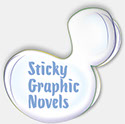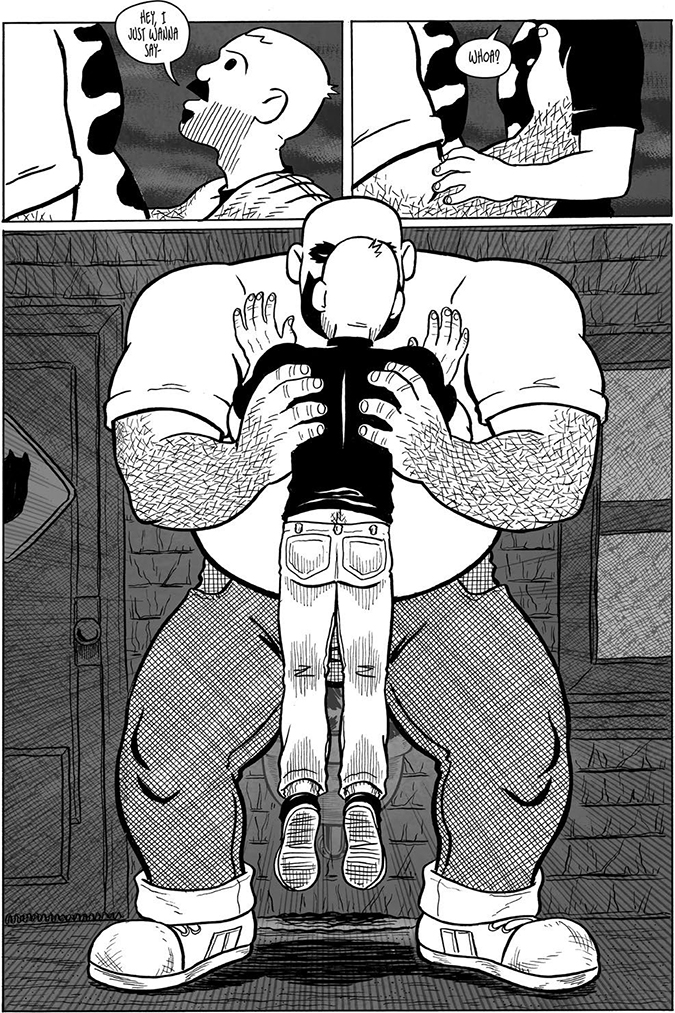- GUTTERFAGS -
Quarterly reviews of sequential art about
dude-on-dude lust and love
-- Back to the front page for more reviews!
Gutterfags is sponsored by Sticky Graphic Novels, an imprint of gay character-based, sex-positive graphic novels published in hardcover by Bruno Gmünder GmbH and in digital format by Class Comics.


WUVABLE OAF
by ED LUCE
reviewed by Mike Martinez for Gutterfags
Wuvable Oaf is a mostly black and white book drawn largely in the style of the late 80’s syndicated strips like Ernie Pook’s Comeek. The main character, Oaf, is presented as a less than bright, overly large, odd-smelling caricature who means well but keeps winding up in impossible situations. We are supposed to gather he isn’t intentionally bad because cats find him irresistible. In fact, the opening chapter finds Oaf being used as a hairy salt lick by a bevy of cats in a manner that borders on bestiality. We are treated to a host of characters who enter and leave the narrative with no real organization or indication why they suddenly become absent.
The book appears to be a compilation of strips and groups of pages that are random rather than put into some form of linear narrative. Chapters jump back and forth in time with no good reason and offer nothing to make the story complete. The author had a chance here to give us a clear story arc. Such a story arc could have been constructed with the material presented. But, for whatever reason the author chose not to.
As an example, Oaf is, despite his rough and tumble appearance, the maker of a unique kind of doll. Oaf shaves off his body hair and uses it as stuffing for dolls which seem to be a hit with the world at large. He possesses the ability to grow back his hair daily. As soon as this sort of cuteness is established, we are taken into a parody of the Hard Rock and Death Metal world. Immediately after, we are presented with a parody of wrestling, and later still with a celebrity chef who creates diabolical meals with his own body fluids and hair.
Any one of these themes would be enough for an entire book that would keep me wanting to read more. As it is presented in such a disjointed style, careering from one topic and joke to another with little hope of connectivity, I just wanted to flip to the page breaks to see if the next section could make some sense of what’s gone before and what’s to come.
Then, as the story arc of the book starts to make sense, we get another boggle type scramble with single-page info dumps that also do not clear up the narrative. Oaf’s one lasting relationship is with one of his adoptive fathers known as Lil Poppa. Lil Poppa runs a feline sanctuary and tries to indulge Oaf so he does no harm to himself or others. There’s also a mentally-disturbed cat. Cats seem to be the running theme here but do not appear in every “chapter”, a term used loosely as the author calls his sections chapters but fails to show how they are connected.
The style, as noted above, is a quaint throwback style that lends itself well to the book. Random bursts of color later in the book are a welcome relief from the monochromatic world of the book. I wish more color had been added because those pieces are quite eye-catching and make you pay more attention to the story being told.
As with many books of this type, where they are collections of earlier work, some attention should have been paid to the story arc. This book is good; it could have been great if it had been better organized. The random, recurring leitmotifs -- pages of cats, short vignettes of sacrifices, wrestling pages that end in blood, etc – which could be acceptable sudden fits and starts or narrative punctuation, are instead disruptions that do not serve the story-telling well.
Oaf is big, he’s hairy, and his attempts to find love do eventually pay off, sort of. The story we are given makes it seem like real love and relationship. Then, instead of sticking with that end in mind, we’re shown vignettes of a different relationship that doesn’t work out in the end and appears to jump in time. We are just sort of left hanging in the air.
That doesn’t make it bad necessarily. It does, however, make it unfulfilling. I say that because the artist clearly has talent but the story reads like it has just been fed through a shredder and hasn’t been pasted back together quite right. There is a cast of characters set of pages that would have been nice to see upfront rather than in a sort of glossary at the end; they are very helpful and give some insights into the motivations of various main and sub characters.
There is an enduring sweetness, here. A gentleness, even as Oaf rolls over onto a bed partner crushing him, or dons a wrestling uniform that spits blood, or when he goes to his father for emotional and moral support. The book just doesn’t fully deliver any of that sweetness into a story that the reader will want to get into and engage with fully.
The dissonant structure leaves this reader at least wanting to go back and edit the chapters to tell the full story we’re given. I would have loved this book completely if the structure had been explained in a credible way. My guess here is that it is organized in a chronological structure that doesn’t always serve the story well. But I would recommend that readers pick up this book because it is well drawn and it is a fine representation of a gay graphic novel. Just go into the book with the idea that you may need to read it a few times to find the story in there. It is worth the effort. I hope that the next book from this author has a more sequential style. It would make the book that much more enjoyable.
- About the reviewer -
Mike Martinez lives in Chicago and works in beta reading, reviewing, and critiquing fiction primarily in the M/M genre. He writes short fiction that makes the City of Chicago as much a character of his works as the people who populate them. He also works in event production for major events and does random child care for a small number of children who benefit from his love of iambic pentameter and all genres of music other than rap.